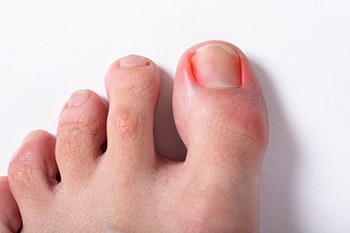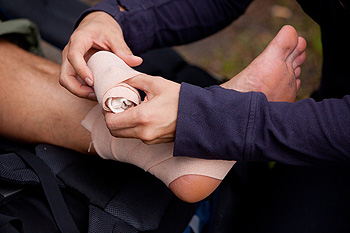Items filtered by date: February 2021
Plantar Warts Can Be Treated!
Why Do Ingrown Toenails Form?
 An ingrown toenail is the result of a curved toenail that grows down into the skin on the sides of the nail. As the toenail digs deep into the skin and the skin continues to grow around it; pain, redness, and swelling can occur. In severe cases, this can lead to an infection that is often indicated by a pus or drainage and usually coincides with a bad odor. Ingrown toenails can have different causes that include trauma to the toe, improperly trimmed nails that are cut too short or on a curve instead of straight across, and footwear that is too tight. The tendency for ingrown toenails may also be inherited or caused by other nail conditions, such as fungal nails. Patients who experience an infection, or those who have recurring ingrown toenails should visit a podiatrist for treatment. A podiatrist can determine what course of treatment is correct for you, as well as administer the proper medication to cease an infection and any corresponding pain.
An ingrown toenail is the result of a curved toenail that grows down into the skin on the sides of the nail. As the toenail digs deep into the skin and the skin continues to grow around it; pain, redness, and swelling can occur. In severe cases, this can lead to an infection that is often indicated by a pus or drainage and usually coincides with a bad odor. Ingrown toenails can have different causes that include trauma to the toe, improperly trimmed nails that are cut too short or on a curve instead of straight across, and footwear that is too tight. The tendency for ingrown toenails may also be inherited or caused by other nail conditions, such as fungal nails. Patients who experience an infection, or those who have recurring ingrown toenails should visit a podiatrist for treatment. A podiatrist can determine what course of treatment is correct for you, as well as administer the proper medication to cease an infection and any corresponding pain.
Ingrown toenails can become painful if they are not treated properly. For more information about ingrown toenails, contact Donald Manger, DPM of Associated Podiatric Physicians, PA. Our doctor can provide the care you need to keep you pain-free and on your feet.
Ingrown Toenails
Ingrown toenails occur when a toenail grows sideways into the bed of the nail, causing pain, swelling, and possibly infection.
Causes
- Bacterial infections
- Improper nail cutting such as cutting it too short or not straight across
- Trauma to the toe, such as stubbing, which causes the nail to grow back irregularly
- Ill-fitting shoes that bunch the toes too close together
- Genetic predisposition
Prevention
Because ingrown toenails are not something found outside of shoe-wearing cultures, going barefoot as often as possible will decrease the likeliness of developing ingrown toenails. Wearing proper fitting shoes and using proper cutting techniques will also help decrease your risk of developing ingrown toenails.
Treatment
Ingrown toenails are a very treatable foot condition. In minor cases, soaking the affected area in salt or antibacterial soaps will not only help with the ingrown nail itself, but also help prevent any infections from occurring. In more severe cases, surgery is an option. In either case, speaking to your podiatrist about this condition will help you get a better understanding of specific treatment options that are right for you.
If you have any questions please feel free to contact our office located in Hamilton Township, NJ . We offer the newest diagnostic and treatment technologies for all your foot and ankle needs.
Managing Pain From an Ankle Sprain
Ankle sprains are common injuries in which the ligaments of the ankle are overstretched or torn due to trauma. The symptoms of an ankle sprain may include pain, soreness, swelling, bruising, difficulty walking, and stiffness in the ankle joint. Although an ankle sprain can be painful at the time of injury, the pain tends to lessen within a couple of weeks. Conservative treatments such as resting, icing, compressing, and elevating the affected ankle and taking nonsteroidal anti-inflammatory medications are typically effective for managing the pain from an ankle sprain. If you have injured your ankle, it is suggested that you seek the care of a podiatrist.
Although ankle sprains are common, they aren’t always minor injuries. If you need your ankle injury looked at, contact Donald Manger, DPM from Associated Podiatric Physicians, PA. Our doctor can provide the care you need to keep you pain-free and on your feet.
How Does an Ankle Sprain Occur?
Ankle sprains are the result of a tear in the ligaments within the ankle. These injuries may happen when you make a rapid shifting movement while your foot is planted. A less common way to sprain your ankle is when your ankle rolls inward while your foot turns outward.
What Are the Symptoms?
- Pain at the sight of the tear
- Bruising/Swelling
- Ankle area is tender to touch
- In severe cases, may hear/feel something tear
- Skin discoloration
Preventing a Sprain
- Wearing appropriate shoes for the occasion
- Stretching before exercises and sports
- Knowing your limits
Treatment of a Sprain
In many cases, the RICE method (Rest, Ice, Compression, and Elevate) is used to treat ankle sprains. However, you should see a podiatrist to see which treatment option would work best with your injury. In severe cases, surgery may be required.
It is important to ask your doctor about rehab options after you receive treatment for your injury. Stretching, strength training, and balance exercises may help the ankle heal while also preventing further injury.
If you have any questions, please feel free to contact our office located in Hamilton Township, NJ . We offer the newest diagnostic and treatment technologies for all your foot care needs.
The Function of the Sesamoid Bones
 One of the functions of the sesamoid bones is leverage. The sesamoids are attached to tendons in the foot, and they are able to provide additional force while pushing off during a running or jumping activity. The sesamoids are located within ligaments under the big toe, and pain can be felt on the ball of the foot when the sesamoids are injured or inflamed. Sesamoiditis is a condition that occurs when the sesamoid bones become inflamed, and is common among runners and dancers. The healing process generally begins with stopping the activity that caused the injury, and it may help to elevate the affected foot. It is beneficial to wear shoes that fit correctly, and the amount of rest needed can be determined by the severity of the condition. If you have pain in this part of your foot, please consult with a podiatrist who can determine if this is sesamoiditis, and offer you the correct treatment options.
One of the functions of the sesamoid bones is leverage. The sesamoids are attached to tendons in the foot, and they are able to provide additional force while pushing off during a running or jumping activity. The sesamoids are located within ligaments under the big toe, and pain can be felt on the ball of the foot when the sesamoids are injured or inflamed. Sesamoiditis is a condition that occurs when the sesamoid bones become inflamed, and is common among runners and dancers. The healing process generally begins with stopping the activity that caused the injury, and it may help to elevate the affected foot. It is beneficial to wear shoes that fit correctly, and the amount of rest needed can be determined by the severity of the condition. If you have pain in this part of your foot, please consult with a podiatrist who can determine if this is sesamoiditis, and offer you the correct treatment options.
Sesamoiditis is an unpleasant foot condition characterized by pain in the balls of the feet. If you think you’re struggling with sesamoiditis, contact Donald Manger, DPM of Associated Podiatric Physicians, PA. Our doctor will treat your condition thoroughly and effectively.
Sesamoiditis
Sesamoiditis is a condition of the foot that affects the ball of the foot. It is more common in younger people than it is in older people. It can also occur with people who have begun a new exercise program, since their bodies are adjusting to the new physical regimen. Pain may also be caused by the inflammation of tendons surrounding the bones. It is important to seek treatment in its early stages because if you ignore the pain, this condition can lead to more serious problems such as severe irritation and bone fractures.
Causes of Sesamoiditis
- Sudden increase in activity
- Increase in physically strenuous movement without a proper warm up or build up
- Foot structure: those who have smaller, bonier feet or those with a high arch may be more susceptible
Treatment for sesamoiditis is non-invasive and simple. Doctors may recommend a strict rest period where the patient forgoes most physical activity. This will help give the patient time to heal their feet through limited activity. For serious cases, it is best to speak with your doctor to determine a treatment option that will help your specific needs.
If you have any questions please feel free to contact our office located in Hamilton Township, NJ . We offer the newest diagnostic and treatment technologies for all your foot and ankle needs.
Running Shoes Are Designed With Thicker Soles
 Many people who are eager to take up the sport of running often start with walking. This generally means that two different pairs of shoes are worn. Walking shoes typically have a lower heel, and shoes that are worn for running have a thicker sole. This adds to the cushioning of the shoe, and the sides can also be thicker. A good pair of running shoes will help to protect the joints, ligaments, and muscles while running is done. This is not necessary while walking, which has a result of less impact on the body. If you would like additional information about the differences between walking and running shoes, please consult with a podiatrist who can provide the information you are seeking.
Many people who are eager to take up the sport of running often start with walking. This generally means that two different pairs of shoes are worn. Walking shoes typically have a lower heel, and shoes that are worn for running have a thicker sole. This adds to the cushioning of the shoe, and the sides can also be thicker. A good pair of running shoes will help to protect the joints, ligaments, and muscles while running is done. This is not necessary while walking, which has a result of less impact on the body. If you would like additional information about the differences between walking and running shoes, please consult with a podiatrist who can provide the information you are seeking.
For more information about walking shoes versus running shoes, consult with Donald Manger, DPM from Associated Podiatric Physicians, PA. Our doctor can measure your feet to determine what your needs are and help you find an appropriate pair of footwear.
Foot Health: The Differences between Walking & Running Shoes
There are great ways to stay in shape: running and walking are two great exercises to a healthy lifestyle. It is important to know that running shoes and walking shoes are not interchangeable. There is a key difference on how the feet hit the ground when someone is running or walking. This is why one should be aware that a shoe is designed differently for each activity.
You may be asking yourself what the real differences are between walking and running shoes and the answers may shock you.
Differences
Walking doesn’t involve as much stress or impact on the feet as running does. However, this doesn’t mean that you should be any less prepared. When you’re walking, you land on your heels and have your foot roll forward. This rolling motion requires additional support to the feet.
Flexibility – Walking shoes are designed to have soft, flexible soles. This allows the walker to push off easily with each step.
If you have any questions, please feel free to contact our office located in Hamilton Township, NJ . We offer the newest diagnostic and treatment technologies for all your foot care needs.


